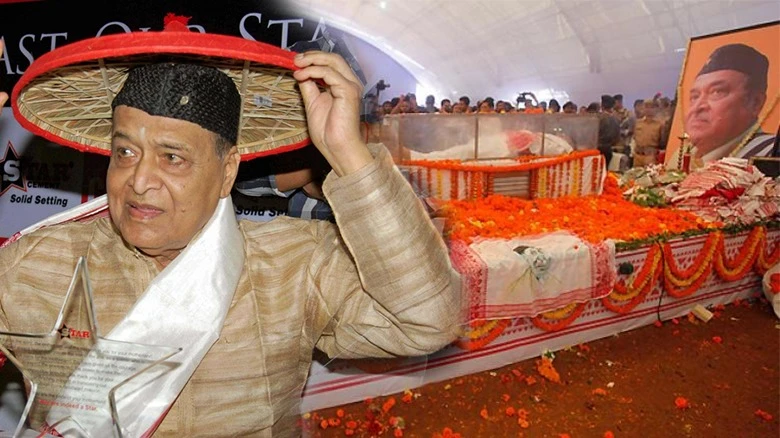Regional

He later turned into a director and produced the acclaimed Assamese films...
Digital Desk: Born on September 8, 1926, to Nilakanta and Shantipriya Hazarika in Sadiya, Assam, Bhupen Hazarika was the eldest among his 10 siblings. He received his singing ability from his mother, who sang lullabies to him and introduced him to the folk music of the state.
Early life and education
A child prodigy, wrote his first song when he was 13 years old. His skill was noticed by prominent Assamese lyricist Jyotiprasad Agarwala and artist Bishnu Prasad Rabha.
After finishing high school in Guwahati, Dhubri, and Tezpur, Hazarika enrolled at Banaras Hindu University, where he earned a BA in 1944 and an MA in political science in 1946. Three years later, he enrolled at Columbia University in New York, where he got his doctorate in 1952.
Musical journey
In New York, Hazarika met Paul Robeson, a notable civil rights leader, who influenced him to write the famous song Bistirno Parore, which is based on Robeson's Ol' Man River imagery and topic. This song, considered one of his epic songs, has been translated into other Indian languages also. He was a member of the All Assam Conference of the Indian People's Theatre Association. He taught at Gauhati University for a few years before leaving to move to Kolkata.
He later turned into a director and produced the acclaimed Assamese films Shakuntala Sur (1961) and Pratidhwani (1964). Lati-Ghati (1966), Chik Mik Bijuli (1969), For Whom the Sun Shines (1974), and Mera Dharam Meri Maa (1974) are a few of his directorial ventures. Additionally, he provided the music for many Assamese and Bengali films, including Shimana Perye (1977), Chameli Memsaab (1975), and Aarop (1973).
Legacy
He is credited with popularizing the culture and folk music of Assam and Northeast India in Hindi cinema on a national scale. He composed and sang songs with themes of humanity and universal brotherhood. He made a significant contribution to Hindi films by writing the music for well-known movies like Arop, Ek Pal, and Rudaali. For the 1993 film Rudaali, he received the National Award for Best Music Director. From 1998 to 2003, he served as Sangeet Natak Akademi's chairman.
Personal life
Hazarika met Priyamvada Patel while studying at Columbia University, and they married in 1950. On November 5, 2011, he died in Mumbai and was cremated on a plot of land given by Gauhati University. His funeral was attended by an estimated half-million people.
Awards & Recognitions
Hazarika was awarded the Padma Shri (1977), Padma Bhushan (2001), and Padma Vibhushan (2016), as well as the Dadasaheb Phalke Award (1992). For Chameli Memsaab, he won the National Award for Best Music Direction and Best Assamese Feature Film in 1975.
He received the Sangeet Natak Akademi Award (1987) as well as the Akademi Fellowship (2008). He received the Asom Ratna, Assam's highest civilian award in 2009. In both 2013 and 2016, he was honoured with commemorative postage stamps.
Interesting facts
1. The music legend was also involved in politics. Hazarika was an independent MLA from 1967 to 1972. He ran unsuccessfully for the Guwahati Lok Sabha constituency on a BJP ticket in the 2004 elections.
2. India’s longest road bridge Dhola-Sadiya, built over river Lohit (Assam), is referred to as Bhupen Hazarika Setu. Bhupen Hazarika Setu is the name of the Dhola-Sadiya, the nation's longest road bridge, which spans the Lohit River in Assam. Moreover, the Barsapara Cricket Stadium in Guwahati has been renamed after Dr. Bhupen Hazarika Stadium in 2010.
3. Since 1986, a documentary about Hazarika's life called Moi Eti Zazabor (I Am a Wanderer), co-directed by the late Waesqurni Bora and Arnab Jan Deka, has been under production.
4. His inclination towards singing developed because as a child he grew up listening to tribal music. He claimed that in the film Rudaali (1993) he used one of his mother's lullabies.
5. For Star TV, he created the tele-series Dawn as well as the 18-part documentary Glimpses of the Misty East, which examined the socio-economic and cultural development of North-East India between 1947 and 1997.
Leave A Comment